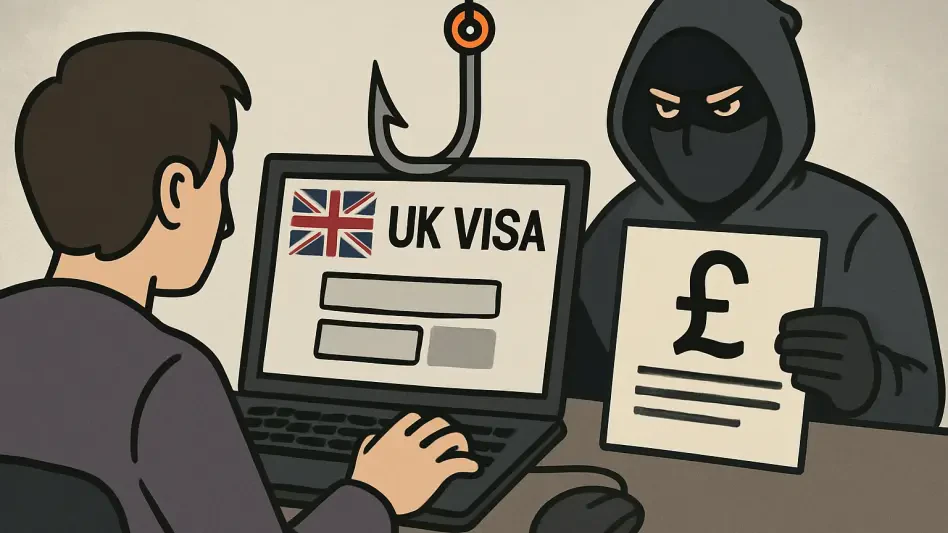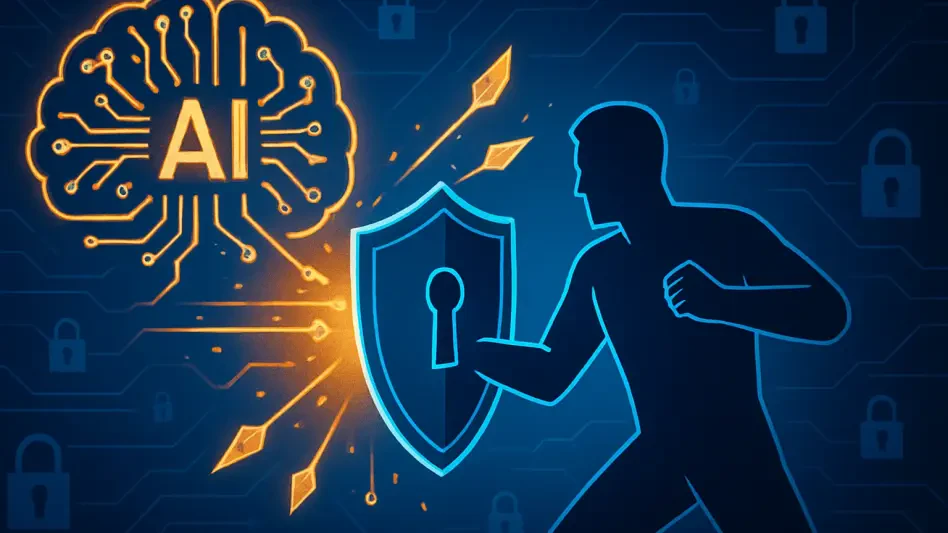Imagine receiving an urgent email from the UK Home Office, warning that your organization’s visa sponsorship account faces immediate suspension unless action is taken within 24 hours. The message looks authentic, complete with official branding and a link to log in and resolve the issue, but this is not a legitimate communication—it’s a sophisticated phishing scam designed to steal sensitive credentials. This alarming scenario underscores a growing cybersecurity threat targeting the UK Visa Sponsorship System, where cybercriminals exploit trust in government systems to perpetrate fraud. This review examines the mechanisms behind these phishing attacks, their impact on organizations and individuals, and the evolving strategies to combat them, shedding light on a critical intersection of technology and immigration security.
Understanding the Phishing Threat Landscape
Phishing scams targeting the UK Visa Sponsorship System have emerged as a significant concern within the cybersecurity domain. These attacks focus on the Sponsorship Management System (SMS), a secure portal used by approved sponsors to manage visa applications. Cybercriminals impersonate the UK Home Office, sending fraudulent communications to trick users into revealing login credentials. This threat extends beyond mere data theft, as it undermines the integrity of immigration processes and poses risks to both organizations and vulnerable individuals seeking legitimate sponsorship.
The relevance of this issue cannot be overstated, as it sits at the crossroads of cybersecurity and immigration fraud. With increasing reliance on digital platforms for government services, the potential for exploitation grows. These scams target not only large corporations but also smaller entities with sponsor licenses, exploiting any lapse in awareness or security protocols. The consequences ripple outward, affecting trust in official systems and highlighting the urgent need for robust defenses against such deceptive tactics.
Key Features of Phishing Campaigns
Deceptive Email Strategies
At the heart of these phishing campaigns lies the use of meticulously crafted emails that mimic official Home Office correspondence. These messages often carry a tone of urgency, warning recipients of account issues or non-compliance penalties that demand immediate attention. Embedded links direct users to counterfeit login pages, exploiting psychological tactics like fear of legal repercussions to prompt hasty actions without verification.
The sophistication of these emails often makes them difficult to distinguish from genuine communications. Subject lines such as “Urgent Account Update Required” or “Compliance Alert” are designed to evoke a sense of panic. Recipients, especially those unfamiliar with phishing red flags, may overlook subtle discrepancies in email addresses or branding, falling prey to the scam’s manipulative design and inadvertently compromising sensitive access.
Technical Design of Fake Login Portals
Beyond deceptive emails, the technical precision of fake SMS login pages stands out as a hallmark of these phishing attacks. These counterfeit websites replicate the legitimate portal with startling accuracy, incorporating government logos, familiar layouts, and even interactive elements like CAPTCHA challenges to enhance authenticity. Such attention to detail lulls users into a false sense of security, encouraging them to input their credentials without suspicion.
A closer examination reveals subtle but critical differences, such as altered form actions that redirect entered data to servers controlled by attackers. This manipulation ensures that stolen credentials are harvested instantly, granting cybercriminals unauthorized access to the SMS. The seamless integration of these fake portals into the broader attack strategy demonstrates a high level of technical expertise, making detection a persistent challenge for even seasoned IT professionals.
Emerging Trends in Phishing Sophistication
The evolution of phishing threats targeting government systems reflects a disturbing trend of increasing complexity. Attackers continuously refine their methods, leveraging detailed replicas of official portals and crafting messages with urgent, authoritative language to bypass user skepticism. This adaptability ensures that even updated security awareness campaigns struggle to keep pace with the latest deceptive techniques.
Another notable trend is the use of advanced evasion tactics to avoid detection by traditional cybersecurity tools. Phishing URLs often closely mimic official web addresses, incorporating minor typos or alternative domains that go unnoticed at a glance. As these threats grow more dynamic, they exploit gaps in both technology and human judgment, necessitating a multi-layered approach to defense that evolves as rapidly as the attacks themselves.
Real-World Consequences and Exploitation
The impact of these phishing scams extends far into the real world, with severe repercussions for affected organizations and individuals. Once attackers gain access to SMS accounts, they often create fictitious job offers, charging exorbitant fees—ranging from $15,000 to $20,000—for fraudulent visa sponsorships. Victims, often desperate for legal entry into the UK, pay these sums only to discover the documents are invalid, leaving them financially devastated.
Organizations holding sponsor licenses face equally dire consequences, including legal liabilities and reputational damage. Breaches can lead to the issuance of counterfeit Certificates of Sponsorship, which may pass initial checks and delay detection, compounding the harm. This exploitation not only disrupts individual lives but also erodes trust in the broader immigration framework, casting doubt on the legitimacy of genuine sponsorship processes.
The financial and systemic fallout underscores a broader challenge to immigration security. Each incident of fraud weakens confidence in digital government platforms, potentially deterring legitimate applicants and sponsors from engaging with the system. Addressing these real-world effects requires not only technical solutions but also policy measures to support victims and restore faith in official channels.
Challenges in Countering Phishing Attacks
Combating UK Visa phishing scams presents numerous obstacles, chief among them the near-impossible task of distinguishing fake websites from legitimate ones at first glance. The high fidelity of these replicas, combined with subtle technical manipulations, often evades casual scrutiny and even some automated detection systems. This persistent mimicry complicates efforts to protect users from falling victim to these schemes.
Additionally, the relentless adaptation by cybercriminals poses a significant barrier. As soon as one phishing tactic is identified and countered, attackers pivot to new strategies, exploiting emerging vulnerabilities or user behaviors. This cat-and-mouse dynamic strains cybersecurity resources, requiring constant updates to detection rules and protective measures to stay ahead of evolving threats.
Legal and financial risks further compound the challenge for sponsors, who may face penalties or loss of license due to breaches, even if unintentional. While firms like Mimecast work to develop advanced detection mechanisms, the scale and adaptability of these scams demand collaborative efforts across sectors. Overcoming these hurdles necessitates a blend of technology, education, and regulatory support to fortify defenses against persistent fraud.
Future Directions for Phishing Defense
Looking ahead, the fight against UK Visa phishing scams hinges on advancements in cybersecurity infrastructure. Innovations such as machine learning-driven anomaly detection could enhance the ability to spot fraudulent communications before they reach users. Integrating such technologies into existing systems offers a proactive shield against the ever-changing tactics employed by attackers.
Equally critical is the adoption of multi-factor authentication for SMS access, adding a vital layer of security that renders stolen credentials less useful. Beyond technical measures, user education remains paramount, equipping individuals with the knowledge to recognize phishing attempts and verify communications through official channels. Regular training initiatives can bridge the gap between technology and human vigilance, creating a more resilient defense network.
The long-term outlook also emphasizes sustained collaboration between government bodies, cybersecurity experts, and sponsor organizations. Building trust in digital immigration systems will require transparent communication about threats and consistent updates to security protocols. As these efforts progress from the current year to 2027, a unified approach will be essential to mitigate risks and safeguard the integrity of visa sponsorship processes.
Final Reflections on the Cybersecurity Challenge
Reflecting on this review, the sophistication of phishing scams targeting the UK Visa Sponsorship System proves to be a formidable adversary for both technology and human awareness. The detailed replication of official portals and the exploitation of trust in government communications reveal a deep vulnerability in digital immigration frameworks. Each element, from deceptive emails to counterfeit login pages, highlights the meticulous planning behind these attacks.
Moving forward, actionable steps emerge as a clear priority to counter this threat. Organizations are urged to implement multi-factor authentication and conduct regular security audits to protect SMS accounts. Equally important is the push for comprehensive staff training to identify suspicious communications, ensuring that human error does not become a gateway for fraud.
Beyond immediate measures, a broader consideration surfaces around fostering international cooperation to tackle cross-border cybercrime. Sharing intelligence on phishing tactics and victim support strategies offers a pathway to strengthen global defenses. This focus on collaborative resilience marks a hopeful direction, aiming to outpace the adaptability of cybercriminals and secure trust in vital systems for years to come.








